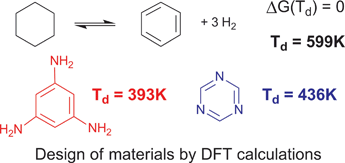Computational structure–activity relationships in H2 storage: how placement of N atoms affects release temperatures in organic liquid storage materials
Abstract
DFT(B3PW91) calculations show that release of H2 is greatly favored thermodynamically in five membered rings over six and by the incorporation of N atoms into the rings, either as ring atoms or as ring substituents, particularly in 1,3 positions.


 Please wait while we load your content...
Please wait while we load your content...